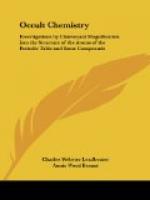COBALT (Plate XVII, 4).
The ovoids in cobalt are identical with those of iron; the higher ovoids, which replace the cone of iron, show persistently the crystalline forms so noticeable throughout this group.
NICKEL (Plate XVII, 5).
The two additional atoms in a bar, which alone separate nickel from cobalt, are seen in the upper sphere of the central ovoid.
RUTHENIUM (Plate XVIII, 1).
The lower ovoids in ruthenium are identical in composition, with those of iron, cobalt and nickel and may be studied under Iron. The upper ones only differ by the addition of a triplet.
RHODIUM (Plate XVIII, 2).
Rhodium has a septet, which is to be seen in the c of titanium (see k in the titanium diagram) and differs only in this from its group.
PALLADIUM (Plate XVIII, 3).
In palladium this septet appears as the upper sphere in every ovoid of the upper ring.
OSMIUM (Plate XVIII, 4).
We have here no new constituents; the ovoids are set free on the proto level and the contained globes on the meta, all being of familiar forms. The cigars, as usual, break free on the proto level, and leave their ovoid with only four contained spheres, which unite into two nine-atomed bodies as in silicon (see above).
IRIDIUM (Plate XVIII, 5.)
The twenty-one-atomed cone of silver here reappears, and its proceedings may be followed under that metal (see diagram, p. 729, May). The remaining bodies call for no remark.
PLATINUM (Plate XVIII, 6).
Again the silver cone is with us. The remaining bodies are set free on the proto level, and their contained spheres on the meta.
LITHIUM (Plate IV, 2, and XIX, 1).
[Illustration]
Here we have some new combinations, which recur persistently in its allies. The bodies a, in Plate XIX, 1, are at the top and bottom of the ellipse; they come to right and left of it in the proto state, and each makes a twelve-atomed body on the meta level.
The five bodies within the ellipse, three monads and two sextets, show two which we have had before: d, which behaves like the quintet and quartet in silicon, after their junction, and b, which we have had in iron. The two bodies c are a variant of the square-based pyramid, one atom at the apex, and two at each of the other angles. The globe, e, is a new form, the four tetrahedra of the proto level making a single twelve-atomed one on the meta. The body a splits up into triplets on the hyper; b and d follow their iron and silicon models; c yields four duads and a unit; e breaks into four quartets.
POTASSIUM (Plate XIX, 2).
Potassium repeats the lithium spike; the central globe shows the “nitrogen balloon,” which we already know, and which is surrounded on the proto level with six tetrahedra, which are set free on the meta and behave as in cobalt. Hence we have nothing new.




